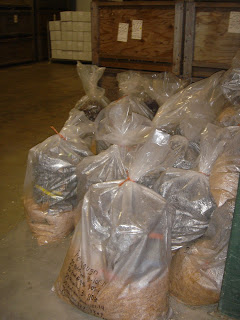

Friday night we had a guest lecturer, the very highly respected field graft expert, Daniel Robledo. He learned from his father, and not only is an entertaining and knowledgeable lecturer, he is one of the top experts in the country on field grafting. We were very fortunate to be able to have him teach our class.

On Saturday Morning we met at Novavine Nursery in Santa Rosa for a tour of the operations. In addition to wine grape vines, they also grown many varieties of olives as seen below.

After a general crash in the grape vine nursery industry in the 90's, Tom Nemcik took over as operations manager with a pledge to turn the nursery into a supplier of the best vines in California. One of his main goals has been to eliminate all toxic chemicals in the nursery production, which is quite an undertaking. Traditional nursery operations are notoirous for intensive use of pesticide, fungicides and other chemicals.
Here Tom explains the process of hot dipping. All plant materials brought into the nursery/greenhouse are hot water dipped to control mealy bug, phyloxera, nematodes and other pests. By hot dipped, I mean submerged in 120 degree water for 5 minutes. All dormant vines being shipped out are dipped again to ensure non-transmission of the crop-devastating diseases.

This is the grafting house. There are 2 kinds of vines here- root stock and scion. In the field, mature shoots called canes are harvested. They are cut into specific lengths, of specific diameters, containing a specific number of nodes. These folks are debudding the root stock.

The scion canes, called bud wood, are cut into 1 bud sections. The ladies at the grafting machines select matching diameter root stock and scion and graft them together in what is called an omega
graft.


Tom shows a nicely grafted cane.

Here we are at the bench grafting machine. One of these women, and they are all women, can put out 1,000 grafts per day. Tom says he likes all women because they have great fine motor control and their hearts have a lot of love, which they impart to the vines. He places high importance on having a calm, serene and joyful production environment, which he believes imparts a good vibrational growth influence to the vines. I like that!

Sanitation is of highest importance in the nursery trade. Instead of chemicals, he uses ozonated water to sanitize all surfaces, materials and the air. This makes the environment safe for the workers too.
Next the finished vines are sprayed with a compost tea and beneficial biologicals cocktail ( such as trichoderma spp), dipped in rooting hormone and packed in hydrated vermiculite. At this point is is a race to help the plant form a strong callus before decomposing fungi start to set in. he does this by strict control of 100% humidity, and temperature of 85 degrees. They also spray the tops of the bins with peracetic acid, which is concentrated form of hydrogen peroxide.

In 10-14 days the vine have reached a good level of callus and some varietals have bud break. Can you find the tiny buds peaking out of the vermiculite?


So at this point they are readied for either field planting or the greenhouse. They are taken out of the vemiculite and dipped into a parafin wax. BTW, if you know anyone who could use some slightly used vermiculite, they need someone to take it off their hands.

These are packed into boxes containing water, to be immediately taken out to their fields and mechanically planted. In a year they will be harvested and ready to ship out to the vineyard that ordered them. Nurseries graft to order, so you have to think 18 months in advance if you want dormant vines to plant in December.

So once the vines are harvested out of the field, washed clean of soil, hot dipped again, they are ready for shipping. They look like this:

They are packed in shavings of pine and fir and kept in cold storage until the vineyard is ready for them.

Another alternative is to grow them in a greenhouse for 10-12 weeks and ship out. Green vines are good for vineyards who procrastinated about their order and want plants NOW. Green vines require more intensive maintenance for success and are not recommended for certain soils or terrains.

To strengthen the plants in the green house, they formulate their proprietary blend of soiless media, which does contain worm castings, regularly apply compost tea, botanicals, and hand tip. Here the baby vines are hardening off in preparation for delivery.

It was a great trip. This nursery is to be commended for it's dedication to it's employees, as well as the vines. By abiding by a philosophy of respecting the plant's own natural defensive properties, and simply paying attention, they are able to produce a high quality plant with no toxic chemicals or synthetic fertilizers.



